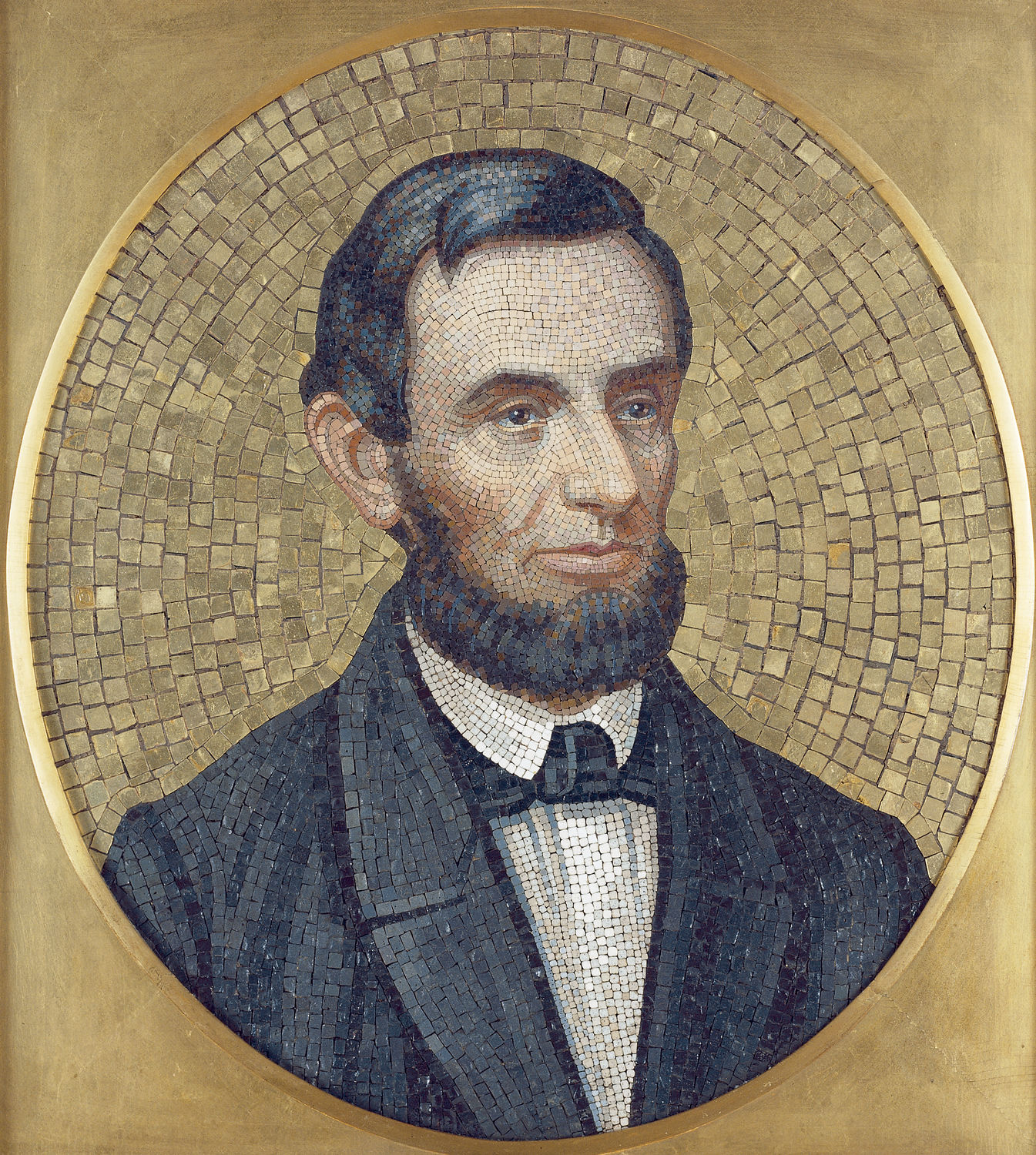
| Title | Abraham Lincoln |
| Artist/Maker | Enrico Podio |
| Date | 1866 |
| Medium | Enamel mosaic |
| Dimensions | Sight: h. 22.75 x w. 20.25 in. (h. 57.785 x w. 51.435 cm)
Framed: h. 33.625 x w. 31.875 x d. 4 in. (h. 85.4075 x w. 80.9625 x d. 10.16 cm) |
| Credit Line | U.S. Senate Collection |
| Accession Number | 39.00001.000 |
Created as a memorial, this mosaic portrait of President Abraham Lincoln was a gift to the United States from Italian businessman and glassworks entrepreneur Antonio Salviati. Salviati established the firm Salviati Dott. Antonio fu Bartolomeo in Venice in 1859 and hired Enrico Podio, who created the Lincoln portrait, to serve as the firm's lead mosaic designer. Salviati's gift of the Lincoln portrait was doubtless both an honest expression of his admiration for the recently slain president—described by Salviati as "one of the world’s greatest heroes"—and an effort to promote his firm's work internationally. The House of Representatives passed legislation accepting the gift on July 24, 1866, and the Senate immediately concurred. Almost 20 years later, a similar portrait made by one of Salviati's later firms, Salviati, Burke & Co., was given to the United States in memory of the nation's second assassinated president, James A. Garfield.
The gift of the Lincoln portrait came early in Salviati's career, which was dedicated to restoring to prominence the medieval art of mosaic. Salviati founded his "laboratory of mosaic art" in Venice in 1859. He showed his works in 1861 at a national exhibition in Florence and in 1863 at an industrial exposition in Vienna. In the years that followed, Salviati exhibited at major expositions in Paris, Naples, London, Milan, and Boston, where he won numerous gold medals and diplomas of honor. At the 1862 London Exposition, the British press touted "the superiority of the enamel work . . . and mosaics sent by the Salviati establishment in Venice." The Salviati company developed a reputation for producing exquisite mosaic portraits of both ancient and modern subjects and for undertaking vast mural decorations for palaces and churches.
Salviati died in Venice on January 25, 1890, leaving his business to his two sons. The firm's mosaic work occupies important architectural spaces in England, including St. Paul's Cathedral, the Houses of Parliament, Westminster Abbey, and the Albert Memorial Chapel. In the United States, the Stanford Memorial Church at Stanford University in California is decorated with massive Salviati mosaics. Salviati's company still produces high-quality glass art today.
Abraham Lincoln, 16th president of the United States, guided the nation through the Civil War and remains respected and honored as one of the world's great leaders. Born in Hardin (now Larue) County, Kentucky in 1809, Lincoln moved with his family to frontier Indiana in 1816, and then to Illinois in 1830. After serving four terms in the Illinois legislature, he was elected as a Whig to the U.S. House of Representatives in 1846. After a single term, he did not seek reelection and returned to Springfield, Illinois, where he established a law practice and gained a statewide reputation as a skilled attorney.
Lincoln ran unsuccessfully as a Whig candidate for the U.S. Senate in 1855. By the time he again sought a Senate seat three years later, he had joined the new Republican Party. During the 1858 campaign, Lincoln engaged Democratic senator Stephen A. Douglas in a dramatic series of public debates. Lincoln ultimately lost the election to Douglas, but he became a national figure.
In 1860 Lincoln became the nation's first Republican president. By the time of his inauguration on March 4, 1861, seven southern states had seceded from the Union. Concerned with preserving the Union from dissolution, Lincoln presented an inaugural address that was conciliatory in nature. “We are not enemies, but friends,” he declared. “We must not be enemies. Though passion may have strained it must not break our bonds of affection. The mystic chords of memory, stretching from every battlefield and patriot grave to every living heart and hearthstone all over this broad land, will yet swell the chorus of the Union, when again touched, as surely they will be, by the better angels of our nature.”
When Confederate forces opened fire on Charleston's Fort Sumter a month later, however, the new president acted decisively. Since Congress was in recess at the time of the attack, Lincoln consulted privately with key members, including Senator Stephen Douglas, and then issued a call for voluntary troops to repel the attack and defend the capital. Over the next four years, as the war continued, Lincoln assumed greater executive power than that of any previous U.S. president.
Of all Lincoln's actions during the Civil War, he is perhaps best remembered for the Emancipation Proclamation, which he issued on January 1, 1863. Although it did not abolish slavery nationwide, it put slaveholders on notice and gave the conflict an undeniable moral imperative. By the time Lincoln took the oath of office at his second inaugural, on March 4, 1865, the war's end was in sight. In his eloquent second inaugural address, the president called for reconciliation among former enemies. “With malice toward none,” he concluded, “with charity for all, with firmness in the right as God gives us to see the right, let us strive on to finish the work we are in, to bind up the nation's wounds, to care for him who shall have borne the battle and for his widow and his orphan, to do all which may achieve and cherish a just and lasting peace among ourselves and with all nations.”
Lincoln's presidency ended abruptly after he was shot by John Wilkes Booth on April 14, 1865, in Washington, D.C.'s Ford's Theatre. He died the following day.